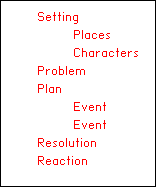Story Maps for Narrative Texts
Middle elementary and above
- Sequence of events
- Character development
- Make predictions
- Writing
- Scaffolding strategy to help students with story retelling
Strategy Steps:
- Make a chart of the elements of narrative structure. Lower elementary children first begin to learn story mapping by identifying and describing what happens at the beginning, middle, and end of a story. For older students, divide the chart into segments labeled as shown:

The events and the resolution may be repeated in complex stories or novels.
- Prepare questions from the story that will lead the students through the story map.
- Discuss the organization of the story and explain the story map.
- During guided reading, use the prepared questions to focus the students’ attention on story structure as they discuss the text.
- If this is a new strategy for the students, after guided reading, model for them how to fill out a story map using a story they have used previously.
- Provide as many demonstrations as needed. Provide guided practice using another previously read story.
- Have students fill in the story map using the new story. They may do this together, independently, or in small groups. Use the prepared questions to provide support, if necessary.
- Provide guided practice as the students compare this story with other story maps they have made.
- Students write a short composition comparing their "new" story map to another map they have already made.